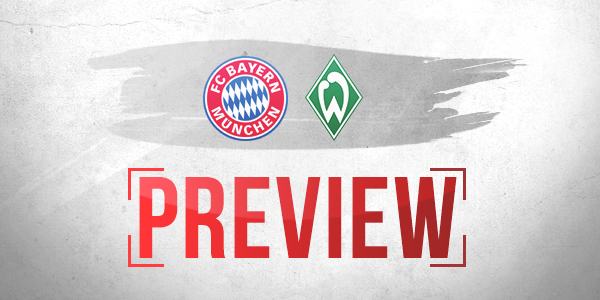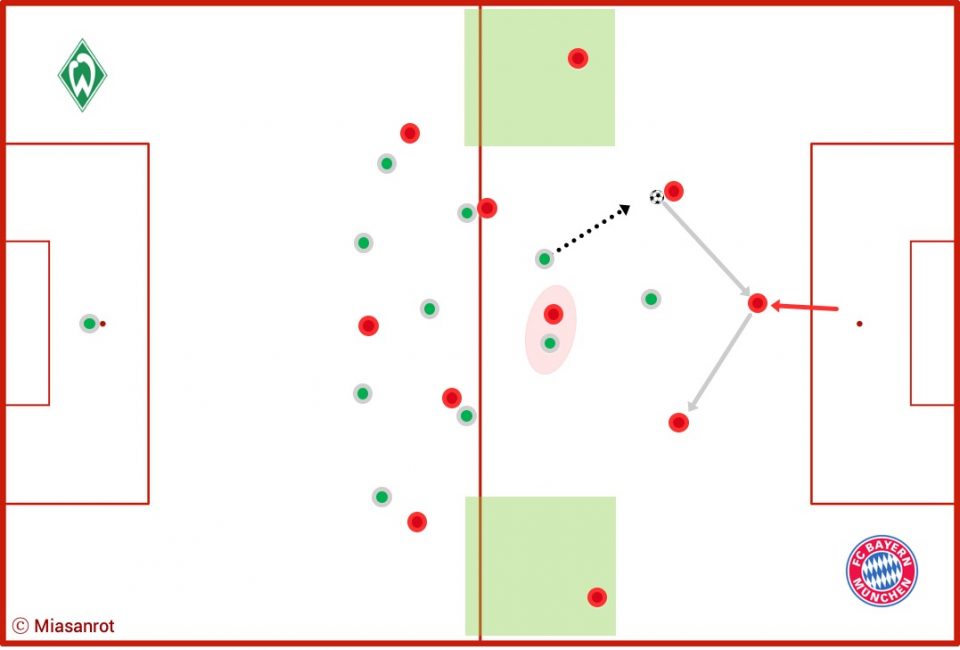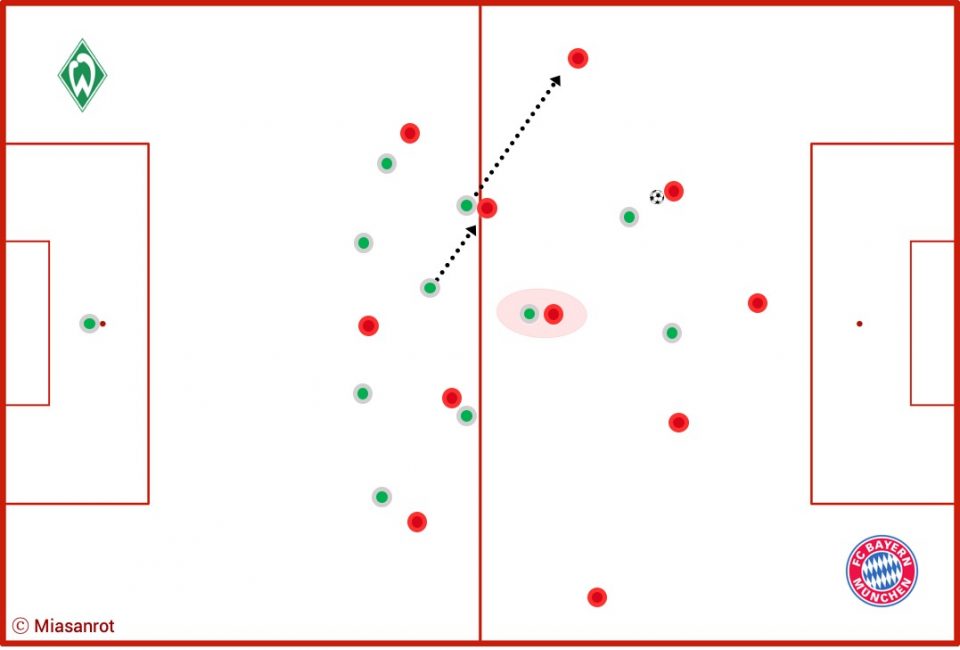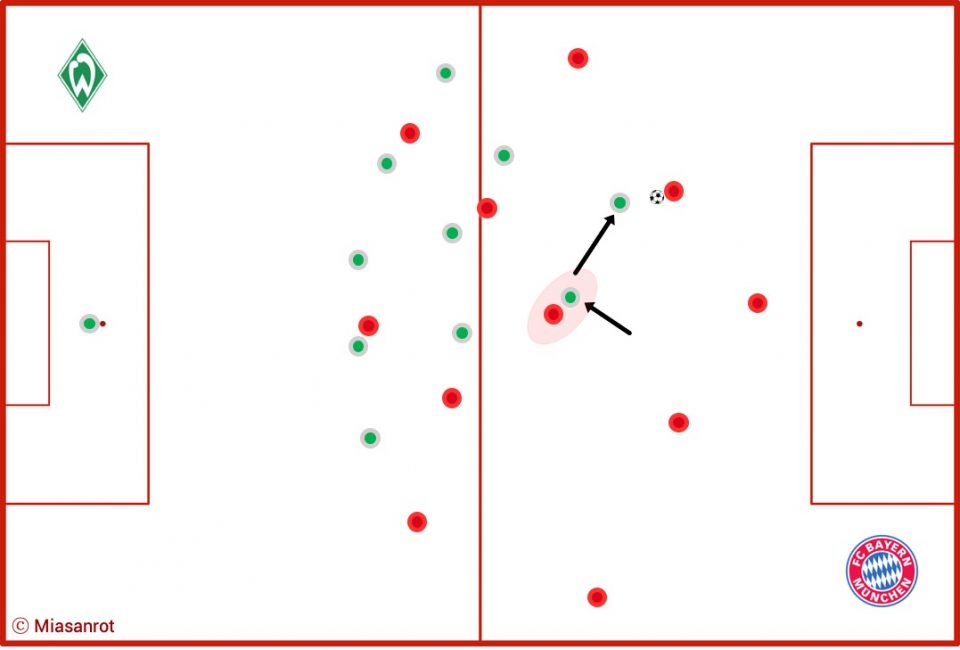Bundesliga MD 15 Preview: Bayern against Bremen
“That they haven’t won their last two games is a joke”, Bremen’s coach Thomas Kohfeldt said ahead of the game against Bayern. His team would have to play against Germany’s best side now and prove that they can compete under pressure, he added.
It is part of the business that coaches of the ostensibly smaller team praise the qualities of their bigger opponent beyond all measure ahead of the match. But Kohfeldt usually is not one of the coaches to fill this stereotype.
And so at the pre-match press conference he did not talk primarily about damage limitation for his team in the Allianz Arena. He wanted his team to play with courage: “Bayern have their weak moments too. They have conceded quite a few goals recently. It’ll be key for us to be brave in possession and use the chances we get.”

The rhythm has been missing
It is not for a lack of courage that Bremen has only been able to collect 14 points and sit in 14th place this season. In the season’s early stages especially, a bizzare spree of injuries among a lot of players left Kohfeldt with not much more than a bare-bones squad. Although this situation has improved in the meantime, with Josh Sargent, Ömer Toprak, Niclas Füllkrug, Fin Bartels, and Kevin Möhwald there are still five long-term absentees remaining.
Kohfeldt thus has been forced to make wholesale adaptations to his team, not just regarding personnel, but also his tactics. He still has not found his best formation. So far, he has tried seven different formations and not played with the same starting eleven twice in a row.
Over the last weeks though, Kohfeldt has been able to reduce his rotation to normal levels. Mostly he has made only one or two changes to his team in recent weeks. Hence, his side has been able to find a better rhythm since the 2-2 draw against Dortmund in September. Of their last ten competitive games, Bremen “only” lost three but could also record just two wins themselves (4-1 against Heidenheim in the DFB-Pokal and 3-2 in Wolfsburg).
Kohfeldt’s 4-3-3 variations
Kohfeldt’s numerous adaptations were not all due exclusively to injuries. He puts great emphasis on getting the details right and always wants to send out a team that is best equipped for the opposition they face. In eight of the last ten games, he had his team start in a very similar formation with marginal adaptions tailored to the respective opponent.
The most salient differences from match to match concern the team’s movements in closing down the opponent players. Against Dortmund, he used a christmas tree shaped 3-2 formation against the ball in midfield that offered Dortmund spaces on the wings while blocking their way through the center. He tried a similar approach against Leverkusen, only that in that match the two central offensive playmakers enjoyed even more liberties than they did against Dortmund. As a result, there was a fluid transition between a diamond with two center-forwards and a wide 4-3-3. Kohfeldt has also experimented with a back three/five earlier this season when he believed the opponent’s threat to come over the flanks. Irrespective of their choice of formation, Bremen’s intensity in pressing has been a reliable factor throughout all matches. Kohfeldt demands his team to keep a compact shape while being aggressive in order to win the ball high up the field.
A potential setup against Bayern
Bremen’s fluidity will have made Bayern’s preparation for this game more complicated than for most other Bundesliag games. Bremen has already played several formations that seem like a good match for Bayern’s 4-1-4-1/4-2-3-1 hybrid. Their christmas tree shaped formation, however, is not among them.

Bremen could afford to keep a low profile on the wings against Dortmund because Dortmund does not have strong creative build-up players there. The long distances Bremen had to cover to close down Dortmund’s wing play did not have a significant effect on the game. Even when Dortmund had time and space there, they hardly ever could take advantage of it.
Bayern, however, has two full-backs in Alphonso Davies and Benjamin Pavard who are able to create a significant goal-threat down the wings. While Pavard is able to strike a decent diagonal ball, Davies’s dribbling skills frequently enable him to use the plenty of grass in front of to him. He won eight of his ten dribbles in the game against Tottenham. Another factor is Manuel Neuer, who likes to take a more active role in the game than Roman Bürki and is also able to have a more calming influence on his teammates than his Dortmund counterpart. With him as a third potential build-up player, Bayern’s then numerical advantage over Bremen’s two central strikers would allow them to switch the play to open spaces. A christmas tree formation would enable Bremen to effectively oppose Bayern’s creativity through the center, but Kohfeldt could achieve this by other means as well.
From Gladbach diamond to Bremen diamond?

Last weekend, he will have seen exactly how Gladbach played against Bayern. He will have observed that Gladbach’s diamond was an attempt not crowned with huge success. In theory, however, a diamond formation remains a realistic option because the fundamental idea behind it is not wrong: two strikers to put pressure on the two central defenders and a wide midfield trio to put pressure on the two number eights and full-backs. And then there is the central playmaker to take care of the pivot in the deep-lying playmaker position.
Depending on the situation, this setup can be easily adapted to a christmas tree formation or a classic 4-4-2 during the game in order to confront Bayern with different challenges and mix up the movements. The biggest difference to Gladbach might be that Werder does not take such a high average on-field position. On the one hand, this will give Bayern the chance of taking an occasional break. On the other hand, Bremen can remain a bit more compact and may be able to keep their diamond shape more effectively than Gladbach.
In all these variations on a basic 4-3-3 theme, the focus will clearly be on isolating Bayern on the wings early and intercept the ball there. The diagonal movement paths from the outside to the inside have to be closed if Bremen wants to ask Bayern any serious questions. Especially that they would get a numerical superiority in the centre is a big argument in favor of a back four.
Courageous back three/five

Of course, a back three/five also remains an option, but it focuses more on the vertical runs of the wing-backs in pressing. The advantage: Bremen’s game would have more width. They could absorb Bayern’s switch plays to the wings more readily and press their full-backs even more aggressively.
The disadvantage is a reduced presence in the center in the final third. There is no free player between the three men midfield and the two strikers up front who can fill the gaps and mark the holding midfielder in Bayern’s six position. This responsibility has to be given and taken flexibly, which could give Joshua Kimmich decisive seconds. However, if one of the five players is assigned to man-mark Bayern’s holding midfielder, the team is either one man short up front to exert pressure, or at the back to have better control against the two number eights and the fluid Lewandowski.
No matter what Kohfeldt ultimately decides: For Werder, a lot will depend on their form on the day. In recent weeks, the team has often had the right plan for the match and has shown itself to be very flexible and capable of adapting to Kohfeldt’s adjustments. However, all this is of little help if individual mistakes defeat the overall plan. Especially against Bayern, Bremen must not allow easy turnovers of possession to occur. They need longer phases in possession to get a rest and a lot of courage on the ball to get something out of the game. In some situations, however, you just need to hit the ball to row Z. Werder sometimes seems too playful and so the search for the right balance continues.
Bayern’s pressing – the devil is in the details
The analysis of Bremen straightforwardly maps out Bayern’s tasks for the weekend. Bremen’s goal of isolating Bayern’s holding midfielders and their full-backs can only be opposed with a good positional game. Against Tottenham, Kimmich and Thiago showed once again that they harmonize well together. Kimmich played 18 passes to the Spaniard, nine of which went through a Tottenham pressing line.
Both also worked well against the ball on Wednesday evening. Thiago had 14 ball recoveries (first rank), Kimmich had eight (together with Davies and Neuer ranked second). Nevertheless, the question of best midfield selection is yet unanswered, not least because Flick is still looking for the right balance of force and creativity.
Yet Bayern still have bigger problems in pressing. Their possession game, largely driven by Philippe Coutinho, Thiago and Kimmich, was marvellous at times against Tottenham. But Coutinho, although he is always very busy, does not have the most outstanding skills against the ball. Thomas Müller’s unplanned substitution helped make up for this to an extent. Nevertheless, slight balance problems still remained. On the wings especially, Bayern have most of their strengths and weaknesses against the ball.

Through their aggressive and man-oriented pressing, especially in the center, Bayern want to provoke uncontrolled or high chip balls out to the wings. As soon as this happens, they shift out to follow the ball immediately in order to exert pressure quickly. The full-backs play a particularly important role in this because they have to aggressively push up on the ball side.
The remaining defense has to close the gaps. In the graphic, Pavard pushes up, the central defenders collectively shift to the right, having to provide a man-on-man cover in defense now. If Bayern’s pressing is overplayed now, their defending often takes the form of a foot race against the opponent’s attackers the way it occasionally did against Leverkusen or Tottenham. Someone like Alphonso Davies is able to prevail in such situations, whereas Jérôme Boateng and Javi Martínez are no longer. This is a large part of the reason why David Alaba has been so crucial for Hansi Flick recently.
The trend is up
The right reaction now, however, would not be to change the playing style to a resemble a wait-and-see approach, as Lothar Matthäus, among others, recently suggested. This did not work out for Niko Kovač already. The aim has to be to be tighter to the opposition, maximise the number of high ball wins, and close any occuring gaps even faster and more consistently with the help of the full-backs. That this is also possible with slower players is something that Pep Guardiola has proven several times in his career.
It will also be important for Flick to be able to recognize and react to changes in the opponent’s movement patterns. But the work on the details will take time, because Bayern have not played such an offensive pressing as they do now for a long time. And yet, this is undoubtedly the way to go for them. Against Bremen, Bayern will be faced with very fast players again. So the game is another opportunity for them to take another step forward in their development.
If the guests are only half as courageous as Kohfeldt demands, the match is the next touchstone for Bayern, albeit not at the level of Gladbach or Leverkusen. But even a hurdle like Bremen has to be cleared first. Things are moving in the right direction yet, but now it is time to redress the problems in the details. For the game at the weekend, the primary goal will be not to add another laugh to the joke.





